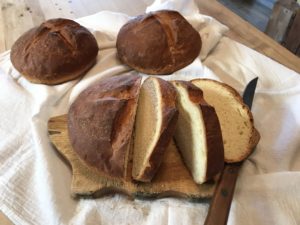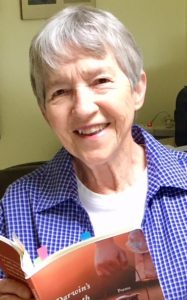That Yeasty Essence
Many of us who write may shy away from the subject of chemistry. Yet we, like chemists, daily deal with basic elements—words shaped into images, voices plucked from the air itself. Making bread and crafting poetry both require getting our hands into the material, sometimes delving elbow-deep.
In the mid-1970s I met a group of women who soon became my writing group. One of the tasks the group set for itself was to try writing various genres in order to enter as many categories in contests as we could find. Doing so was our way of stretching our minds and finding out what we most enjoyed—and perhaps were best at—writing.
At the time I was writing short stories for young people and was building up courage to try my hand at drafting a novel for the middle-school market. In 1978 I began writing a weekly column for my local newspaper, a venture that would last 42-and-a-half-years. Although I had written poetry as an undergraduate, I had struggled with iambic pentameter, perfectly rhymed lines and was convinced poetry required skills far beyond my abilities.
One July afternoon, I sat at my kitchen table, cooling off in front of a fan while the week’s bread rose on the counter top. I flipped through the latest issue of The Writer’s Digest and browsed Judson Jerome’s poetry column. That month’s article discussed a woman poet who had written a successful poem about repairing motorcycles, a subject as far beyond the scope of my knowledge as was poetry itself. But something in the article caught my attention: Write about the thing you know how to do and love to do, Jerome advised.
I looked at the bowl where dough now pushed against the towel covering it, at the measuring cup and spoons nearby, the smattering of flour still waiting to be wiped off the counter. And I got out a pad of paper and a pencil.
That first real poem of my poetry-writing life was titled “Baking Bread on a Summer Afternoon.” It won an award in the next contest the writing group entered, all the validation I needed to launch into writing poem after poem, a long road of discovery I’m still traveling.
Here is that original, over-written poem:
Baking Bread on a Summer Afternoon
Yeast dissolving
sends vapors of earth’s beginning
into my sweat-beaded nose.
Ridges in the cool linoleum
rub their backs against the bottoms
of my bare feet while I cross—
refrigerator to table to tea-stained,
porcelain-chipped sink.
Brown eggs drop golden globes
into the earthen bowl. Flour flies
upward finely powdering
each hair on my arm.
Fingers pulled from quicksand
on the flour-bedded table top
hang together by thick strands
no earthly spider spun.
Perspiration pours from each hair root,
over stretched neck skin, losing
its sea being in my tee shirt.
Dough mounds breathe and bubble
in Crisco-whitened pans while I stretch
from chair to stool, iced tea drenching
my island of thirst. Now my kitchen
fills with sweet bread rising,
wrapping five figures close. Next week,
perhaps, I’ll bake bread again.
Country Egg Bread  2 cups hot water
2 cups hot water
2 packages yeast
1/2 cup butter or margarine
1/2 cup dry milk
2 teaspoons salt
2 beaten eggs
1/2 cup sugar
about 8 cups bread flour
Pour the hot water over the butter, salt, and sugar. Cool. Dissolve the yeast in the lukewarm water and let it stand until it bubbles, about 5 minutes. Add the dry milk. Add the beaten eggs. Gradually add the flour, beating it in thoroughly. Do not add any more flour than is necessary to make an easily handled dough, as the bread should be light and tender. (Only 7 cups may be needed in humid weather.)
Turn out onto a floured board and knead until smooth and elastic. Place in greased bowl, turning once to grease the top of the dough. Cover and let rise until doubled in size, about an hour (a little longer in cold weather).
Punch down and turn out onto a lightly floured board. Divide into four portions and shape each into a smooth ball. Grease four pie plates. Place a ball of dough in each pie plate, turning once to grease the top of the dough. Cover and let rise until doubled, about 45 minutes on a warm day.
Using an extremely sharp knife, slit the top of each loaf. Preheat the oven to 425, but turn the temperature down to 350 when you put the bread into the oven. Bake for 25 to 30 minutes.
Variation: Substitute ½ cup honey for the sugar and 4 cups whole-wheat flour for part of the bread flour. You can also add ¼ cup wheat germ for a portion of the flour.
BIO Connie Jordan Green is the author of novels for young people, poetry chapbooks and collections, and a personal newspaper column that ran for more than 42 years. Green is included in Listen Here: Women Writing in Appalachia(University Press of Kentucky). Her poetry has appeared in numerous journals and anthologies. She taught creative writing for the University of Tennessee and continues to teach at various workshops. She and her husband Richard, a retired engineer, have three children and seven grandchildren.
Connie Jordan Green is the author of novels for young people, poetry chapbooks and collections, and a personal newspaper column that ran for more than 42 years. Green is included in Listen Here: Women Writing in Appalachia(University Press of Kentucky). Her poetry has appeared in numerous journals and anthologies. She taught creative writing for the University of Tennessee and continues to teach at various workshops. She and her husband Richard, a retired engineer, have three children and seven grandchildren.

